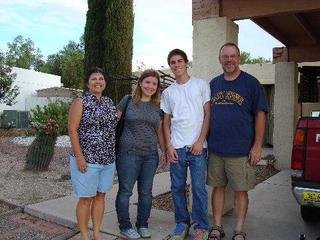
We now have 4 members on our Catalina UMC Race for the Cure team! Get busy signing up!!
This is a place where we can reflect on our faith journey, add resources and comments and ideas for further thinking, and hopefully relate to each other. This place is specifically targeted toward The Refuge, the alternative worship congregation at Catalina UMC, but anyone is welcome!
History of Palm Sunday
As soon as the Church obtained her freedom in the fourth century, the faithful in Jerusalem re-enacted the solemn entry of Christ into their city on the Sunday before Easter, holding a procession in which they carried branches and sang the Hosanna (Matthew 21, 1-11). In the early Latin Church, people attending Mass on this Sunday would hold aloft twigs of olives, which were not, however, blessed in those days.
This Palm Sunday procession, and the blessing of palms, seems to have originated in the Frankish Kingdom. The earliest mention of these ceremonies is found in the Sacramentary of the Abbey of Bobbio in northern Italy (beginning of the eighth century). The rite was soon accepted in Rome and incorporated into the liturgy.
Everywhere in medieval times, following the Roman custom, a procession composed of the clergy and laity carrying palms moved from a chapel or shrine outside the town, where the palms were blessed, to the cathedral or main church. Our Lord was represented in the procession, either by the Blessed Sacrament or by a crucifix, adorned with flowers, carried by the celebrant of the Mass. Later, in the Middle Ages, a quaint custom arose of drawing a wooden statue of Christ sitting on a donkey (the whole image on wheels) in the center of the procession. These statues (Palm Donkey; Palmesel) are still seen in museums of many European cities.
PASSION SUNDAY
In the past, Passion Sunday was celebrated the week before Palm Sunday. So you had Christ crucified before he ever entered Jerusalem. This was rectified in the Revised Common Lectionary, and Palm and Passion Sunday came to share the same week. Hoyt Hickman in The New Handbook for the Christian Year says this. “Many persons have asked why the new calendar and lectionary now shared by historic Christian traditions have combined Passion and Palm Sunday into one and have suggested such an extensive amount of Scripture. To understand why this has been done , one must first recognize that the passion story is a highly dramatic and unified whole and is absolutely central to each of the Gospels. It demands to be heard in its wholeness, rather than in small bits and pieces. To focus on this story one Sunday and then the following Sunday to back up to the entry of Jesus into Jerusalem breaks the unity of the whole sweep of events from the triumphant entry through the passion and crucifixion to the resurrection. There is also a pastoral reality to face. Most persons in church on Passion/Palm Sunday will not be there again until Easter Day. To go abruptly from the lesser joy of the entry into Jerusalem to the joy of Easter, without being addressed by the passion and the cross of our Lord, is to impoverish our experience of the Gospel.”
THE STATIONS OF THE CROSS
For Roman Catholics throughout the world, the Stations of the Cross are synonymous with Lent, Holy Week and, especially, Good Friday. This devotion is also known as the "Way of the Cross", the "Via Crucis", and the "Via Dolorosa." It commemorates 14 key events on day of Christ's crucifixion. The majority concern His final walk through the streets of Jerusalem, carrying the Cross.
The Stations originated in medieval Europe when wars prevented Christian pilgrims from visiting the Holy Land. European artists created works depicting scenes of Christ's journey to Calvary. The faithful installed these sculptures or paintings at intervals along a procession route, inside the parish church or outdoors. Performing the devotion meant walking the entire route, stopping to pray at each "station."
Today, images of the Stations (or simple crosses representing them) are on display in almost all Catholic churches. They serve mainly as a focus for Lenten worship services. But the Stations can also be performed privately, at any time of the year, even at home. Many organizations offer free or inexpensive, illustrated pamphlets for this purpose.
http://www.ixeh.net/faith/Stations/via-info.html
Although Catholic in origin, the stations have been adopted for meditation, prayer, and practice by many Christian groups.
